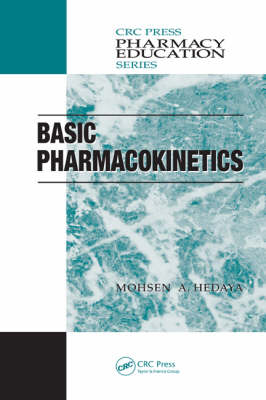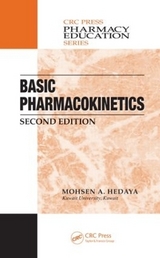
Basic Pharmacokinetics
Crc Press Inc (Verlag)
978-1-4200-4671-7 (ISBN)
- Titel erscheint in neuer Auflage
- Artikel merken
This volume is a self-instructional computer-assisted medium for active learning. Indeed, the tutorial materials included in the accompanying compact disk have received an award from the American Association of Colleges of Pharmacy for innovation in teaching. This volume and its companion CD are intended for students and practitioners in the health professions who need to comprehend the concepts and principles related to how the body absorbs, distributes, metabolizes, and excretes drugs.
"…The author's reliance on active learning, his use of examples illustrating important pharmacokinetic principles, and particularly the thoughtful simulation tools he has developed make this text and its companion CD an extremely effective and enjoyable introduction to the field of pharmacokinetics."
From the Foreword, Ronald J. Sawchuk Minneapolis, Minnesota
Pharmacokinetics has become an essential component of all the processes involved in drug development, discovery, and preclinical evaluation, as well as with the clinical use of drugs. While this has led to the development of many highly complex techniques, basic pharmacokinetic concepts remain the backbone of all these new developments. Consequently, a thorough understanding of the basic concepts is essential before one can tackle the more involved and applied areas of pharmacokinetics.
Basic Pharmacokinetics consists of two parts: textual printed materials and highly interactive computer-based presentations. Together, these provide a useful combination that makes it easy to grasp basic principles. The computer-based information is presented in a self-instructional format, which introduces concepts, utilizing highly interactive graphical presentations and simulations. It visualizes the interplay between the different pharmacokinetic parameters, observing how the change in one or more of these parameters impacts the drug concentration-time profile in the body.
Uniquely and carefully designed, the learning modules in the CD closely support and complement the text, providing the learner with an opportunity to reinforce his or her understanding of the principles presented.
Tanta University, Egypt
INTRODUCTION TO BIOPHARMACEUTICS AND PHARMACOKINETICS
Application of the Biopharmaceutic and Pharmacokinetic Principles in the Biomedical Fields
Pharmacokinetic Modeling
Pharmacokinetic Simulation
DRUG PHARMACOKINETICS FOLLOWING SINGLE INTRAVENOUS ADMINISTRATION
The Elimination Rate Constant
The Volume of Distribution
The Half-life
The Total Body Clearance
The Area under the Curve
Factors Affecting the Drug Blood Concentration-time Profile after a Single IV Bolus Dose
DRUG ABSORPTION FOLLOWING ORAL ADMINISTRATION: BIOPHARMACEUTICAL CONSIDERATIONS
Physiological Factors Affecting Oral Drug Absorption
Physical Factors Affecting Oral Drug Absorption
The Dosage Form Characteristics
DRUG PHARMACOKINETICS FOLLOWING SINGLE ORAL DRUG ADMINISTRATION: THE RATE OF DRUG ABSORPTION
Drug Absorption after Oral Administration
The Plasma Concentration-Time Profile after a Single Oral Dose
Determination of the Absorption Rate Constant
Clinical Importance of the Absorption Rate Constant
DRUG PHARMACOKINETICS FOLLOWING SINGLE ORAL DRUG ADMINISTRATION: THE EXTENT OF DRUG ABSORPTION
The Purpose of the Bioavailability and Bioequivalence Studies
Causes for Variation in Drug Bioavailability
Pharmacokinetic Basis of Drug Bioavailability
and Bioequivalence
Determination of the Drug Bioavailability
Regulatory Requirements for Bioavailability and Bioequivalency
Factors Affecting the Blood Concentration-time Profile after a Single Oral Dose
THE STEADY-STATE PRINCIPLE AND DRUG PHARMACOKINETICS
DURING CONSTANT-RATE INTRAVENOUS INFUSION
The Plasma Concentration during Continuous Constant-Rate IV Drug Administration
The Time Required to Reach Steady-State
Loading Dose
Determination of the Pharmacokinetic Parameters
Effect of Changing the Pharmacokinetic Parameters on the Steady-State
Plasma Concentration during Constant-Rate IV Infusion
STEADY-STATE DURING MULTIPLE DRUG ADMINISTRATIONS
The Drug Plasma Concentration-time Profile during Multiple Drug
Administrations
Average Plasma Concentration at Steady-State
The Time Required to Reach Steady-State
Loading Dose
Drug Accumulation
Controlled-release Formulations
Effect of Changing the Pharmacokinetic Parameters on the Steady-State Plasma Concentration during Repeated Drug Administration
Dosage Regimen Design
RENAL DRUG ELIMINATION.
Mechanisms of Renal Excretion of Drugs
Determination of the Renal Excretion Rate
The Renal Clearance
The Cumulative Amount of the Drug Excreted in Urine
Determination of the Pharmacokinetic Parameters from the Renal Excretion Rate Data
Effect of Changing the Pharmacokinetic Parameters on the Urinary Excretion of Drugs
METABOLITE PHARMACOKINETICS
Simple Model for Metabolite Kinetics
General Model for Metabolite Kinetics
Estimation of the Metabolite Pharmacokinetic Parameters
The Effect of Changing the Pharmacokinetic Parameters on the Drug and Metabolite Concentration-time Profiles after a Single IV Drug Administration
Steady-State Metabolite Concentration during Repeated Administrations of the Parent Drug
Effect of Changing the Pharmacokinetic Parameters on the Steady-State Drug and Metabolite Concentrations during Repeated Drug Administrations
DISEASE STATE AND DRUG PHARMACOKINETICS
Patients with Kidney Dysfunction
Patients with Liver Diseases
NONLINEAR PHARMACOKINETICS
Michaelis-Menten Enzyme Kinetics
Determination of the Pharmacokinetic Parameters
Effect of Changing the Pharmacokinetic Parameters on the Plasma Concentration-time Profile
Oral Administration of Drugs Eliminated by a Michaelis-Menten
Process
Pharmacokinetic Parameter Determination and Dosage Recommendation
MULTICOMPARTMENT PHARMACOKINETIC MODELS
The Two-Compartment Pharmacokinetic Model
The Parameters of the Two-compartment Pharmacokinetic Model
Determination of the Two-Compartment Pharmacokinetic Model Parameters
Effect of Changing the Pharmacokinetic Parameters on the Drug
Concentration-time Profile After a Single IV Dose
Oral Administration of Drugs that Follow the Two-compartment
Pharmacokinetic Model
Constant Rate IV Administration of Drugs that Follow the Two-Compartment Pharmacokinetic Model
Multiple Drug Administrations
Renal Excretion of Drugs that Follow a Two-Compartment
Pharmacokinetic Model
Effect of Changing the Pharmacokinetic Parameters on the Drug
Distribution between the Central and Peripheral Compartments
The Three-Compartment Pharmacokinetic Model
DRUG PHARMACOKINETICS FOLLOWING ADMINISTRATION BY INTERMITTENT INTRAVENOUS INFUSION
The Drug Concentration-time Profile During Intermittent IV Infusion
Effect of Changing the Pharmacokinetic Parameters on the Steady-State Plasma Concentration During Repeated Intermittent IV Infusion
Application of the Pharmacokinetic Principles for Intermittent IV Infusion to the Therapeutic Use of Aminoglycoside
Individualization of Aminoglycoside Therapy
NONCOMPARTMENTAL APPROACH TO PHARMACOKINETIC DATA ANALYSIS
The Noncompartmental Approach in Data Analysis
The Mean Residence Time
Other Pharmacokinetic Parameters that can be Determined Using the Noncompartmental Approach
PHYSIOLOGICAL APPROACHTO HEPATIC CLEARANCE
Organ Clearance
Hepatic Extraction Ratio
Intrinsic Clearance (CLint)
Systemic Bioavailability
The Effect of the Change in Intrinsic Clearance and Hepatic
Blood Flow on the Hepatic Clearance, Systemic Availability, and Drug Concentration-time Profile
Protein Binding and Hepatic Extraction
PHARMACOKINETIC-PHARMACODYNAMIC RELATIONSHIP
Pharmacodynamic Models
The Link between the Pharmacokinetic and the Pharmacodynamic
Models
Application of Pharmacodynamic Models
THERAPEUTIC DRUG MONITORING
General Principles of Initiation and Management of Drug Therapy
The Therapeutic Range
The Variability in the Drug Pharmacokinetics and Response
Advantages of Therapeutic Drug Monitoring
Candidate Drugs for Therapeutic Drug Monitoring
Methods for Measuring Drug Blood Concentrations
Establishing a Therapeutic Drug Monitoring Service
SOLUTIONS FOR THE PRACTICE PROBLEMS
| Erscheint lt. Verlag | 23.4.2007 |
|---|---|
| Reihe/Serie | Pharmacy Education Series |
| Zusatzinfo | 241 equations; 1 Halftones, black and white; 3 Tables, black and white; 104 Illustrations, black and white |
| Verlagsort | Bosa Roca |
| Sprache | englisch |
| Maße | 156 x 235 mm |
| Gewicht | 606 g |
| Themenwelt | Medizin / Pharmazie ► Medizinische Fachgebiete ► Pharmakologie / Pharmakotherapie |
| ISBN-10 | 1-4200-4671-3 / 1420046713 |
| ISBN-13 | 978-1-4200-4671-7 / 9781420046717 |
| Zustand | Neuware |
| Informationen gemäß Produktsicherheitsverordnung (GPSR) | |
| Haben Sie eine Frage zum Produkt? |
aus dem Bereich



